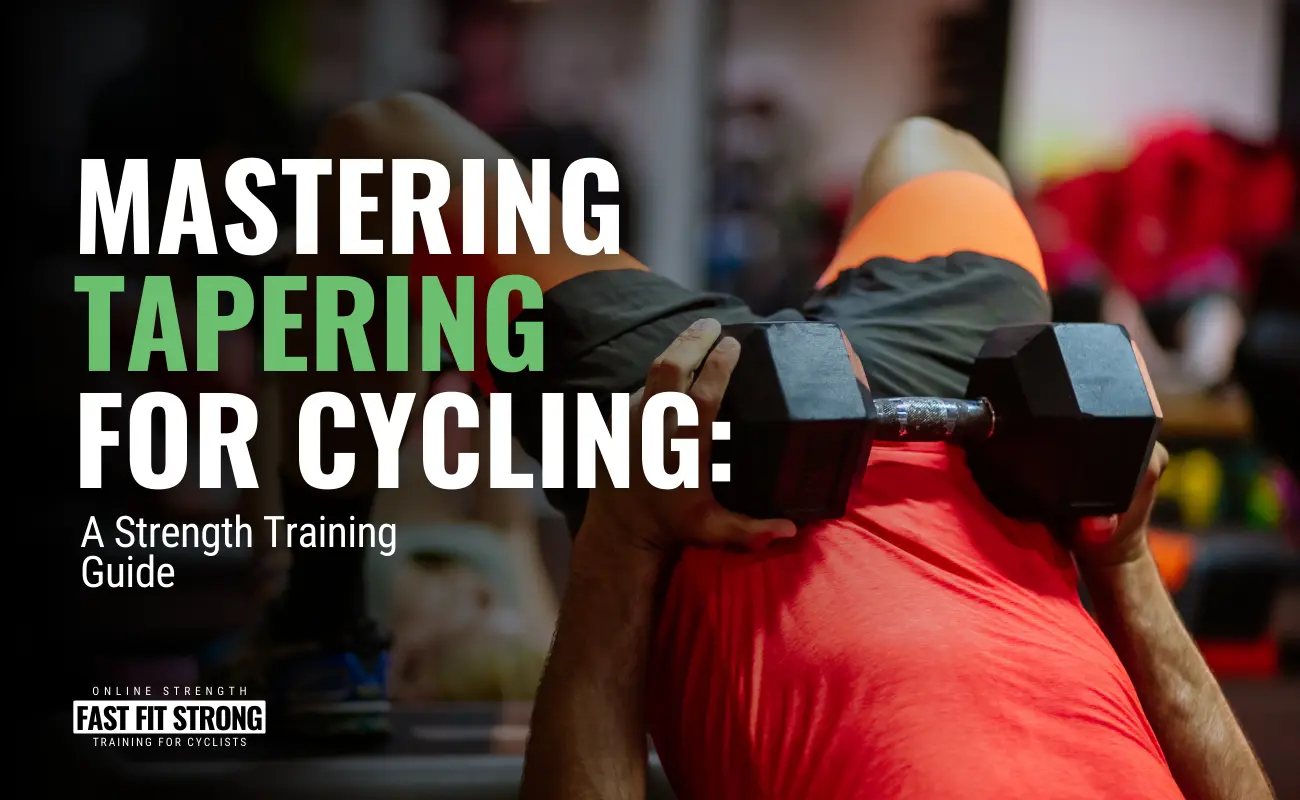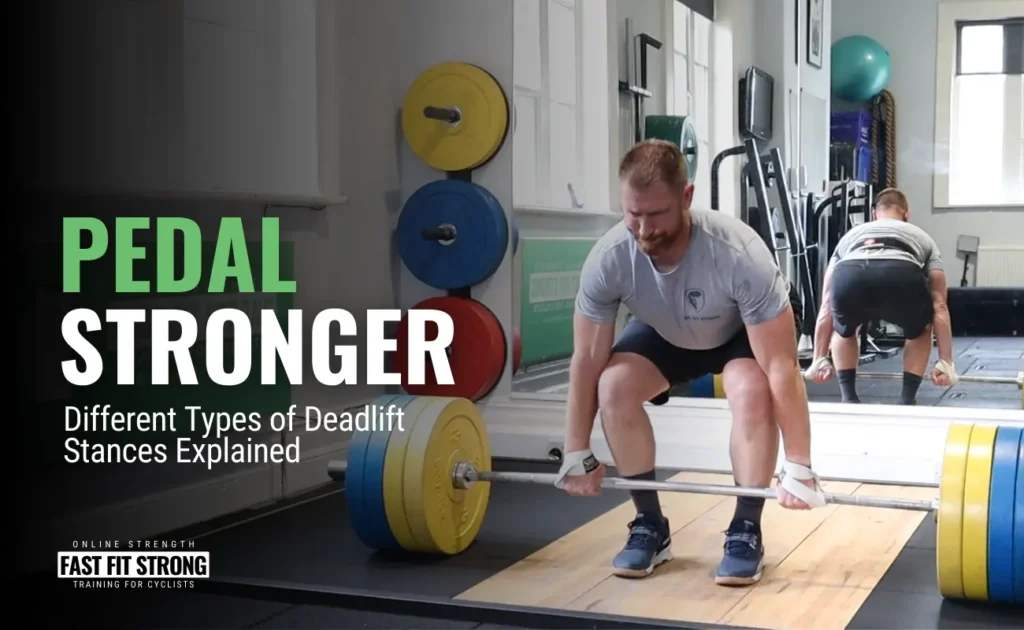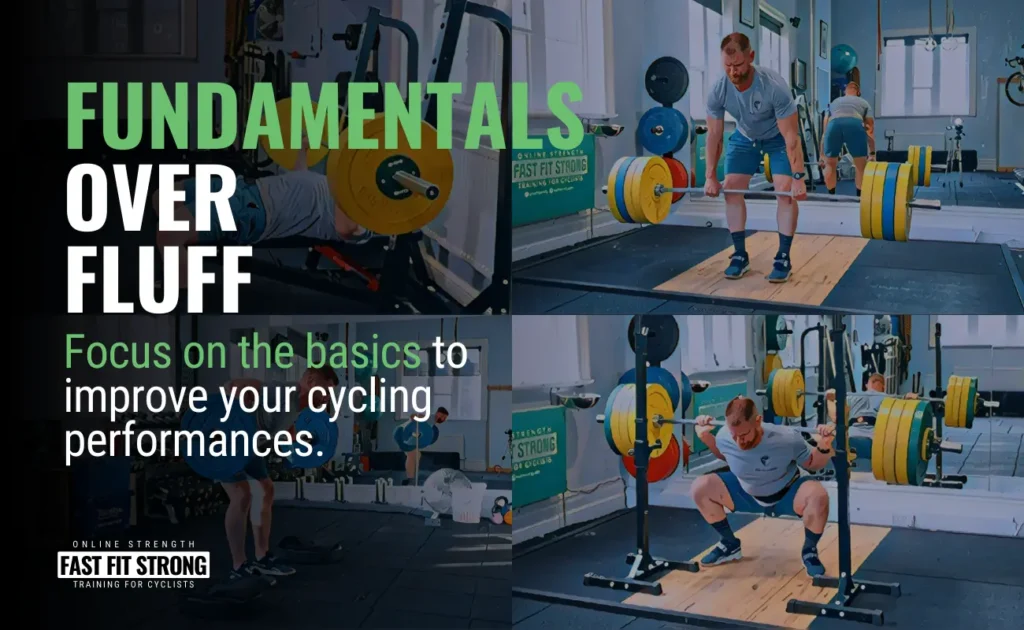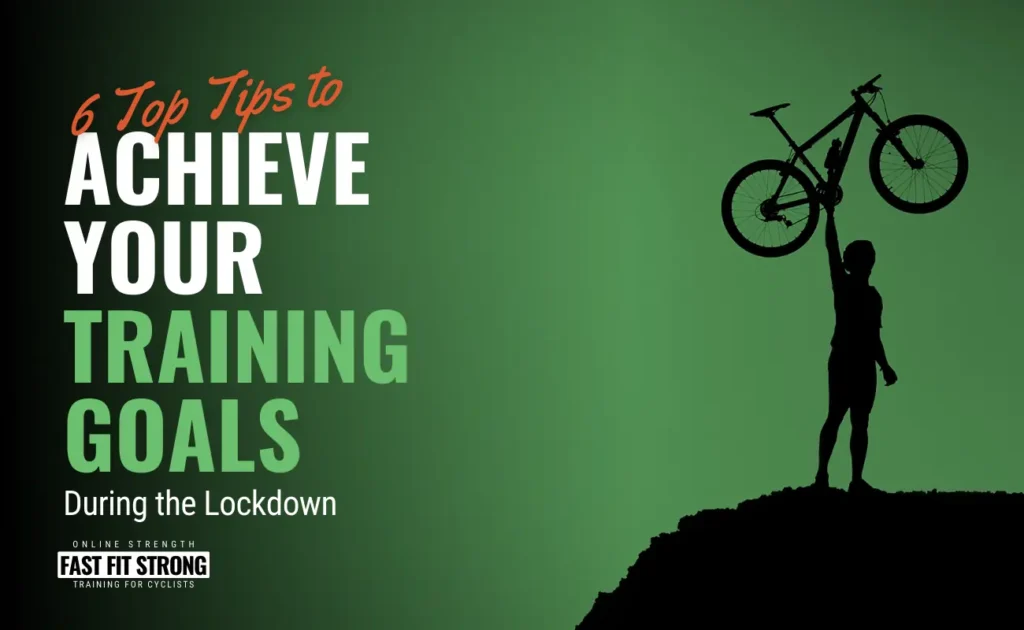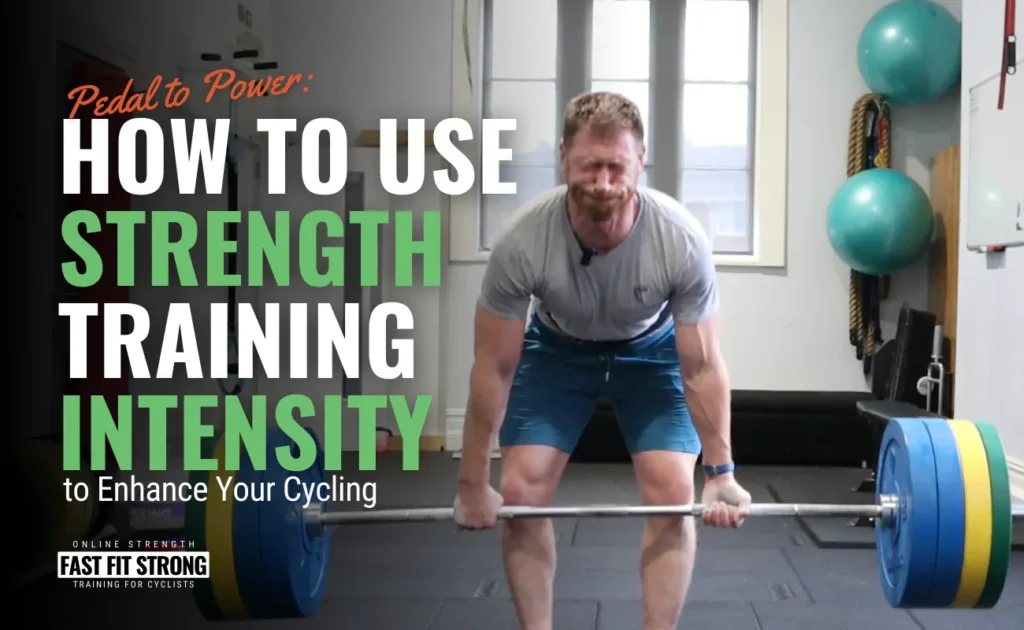Introduction
As the sun rises on the day of your major event and the anticipation of what’s in store for you looms, every cyclist seeks that extra edge to propel them to victory. The path to peak performance isn’t solely paved by the sessions you’ve completed or the miles you’ve pedalled; it still has to be enhanced with the art of the taper.
A good quality taper navigates many competing factors and, when done well, integrates your strength and cycling training, enhancing your potential to elevate your performance to new heights!
In this guide, I’ll unveil some of the tapering secrets I’ve learned from coaching some of the best cyclists in the world to Olympic gold and explore how it harmoniously integrates with strength training to refine your race-day readiness. We’ll navigate the benefits that await those who master the taper, steer clear of the pitfalls that can trip up even the most seasoned riders, and unveil the methods that are as diverse as the peloton itself. So, whether you’re a competitive road racer eyeing multiple podiums or a passionate weekend rider setting your sights on that one monumental event, this guide is perfect for you.
But before we begin, let’s start by understanding why tapering isn’t just a passive descent but rather an art form that primes your body for peak performance.
Benefits of Tapering for Cyclists
When the big day arrives, you want to be at the peak of your capabilities. After weeks and months of hard training on and off the bike, a well-thought-out and executed tapering strategy is what delivers you to that peak. In general, maintaining your training intensity, while systematically reducing your training volume allows your body to recover from the accumulated stress of recent training and the subsequent “supercompensation” boosts your power, endurance, and mental focus.
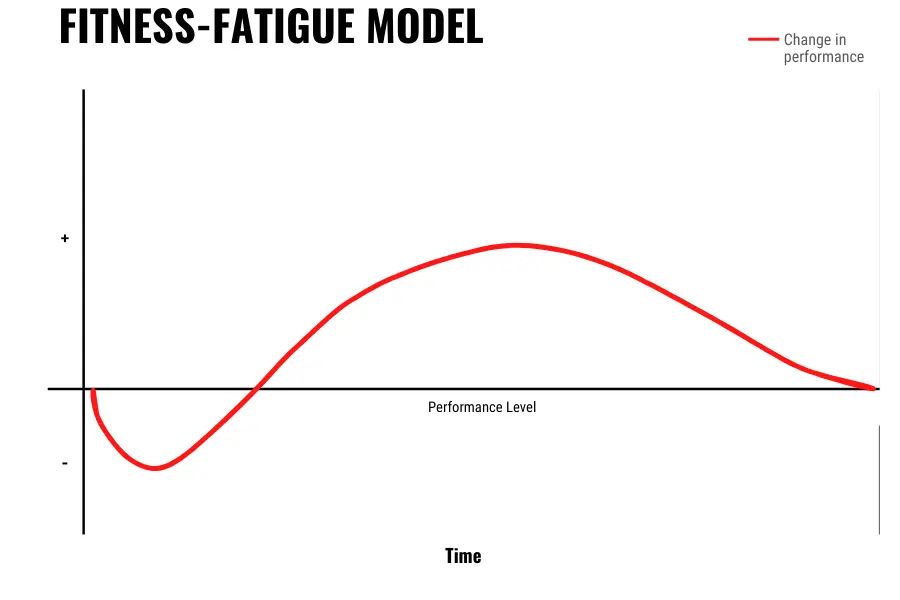
Fighting Fatigue: A Symphony of Recovery
Every rider wants to feel like they’ve done everything they can to be as fit as possible for the event, but for many, this means either not tapering at all, or tapering too late and they carry excessive fatigue into the event.
A sensible tapering strategy eliminates fatigue while maintaining readiness. As you taper, your body replenishes energy stores, repairs microscopic tears in muscle fibres, and rejuvenates the nervous system. The result? Reduced muscle soreness, improved muscle function, and enhanced nerve-to-muscle communication. This recovery equips you with a body that’s primed for peak performance, so do the work upfront and rely on your tapering strategy to benefit from that work when it matters most.
Unveiling Hidden Gains: Adaptation Amplified
Tapering magnifies the adaptation your body underwent during the training phase. As the training load reduces, your body is free to channel its resources towards adaptation. Think of it like this; the heavier training blocks are where you develop your physical abilities, but sensible tapering allows you to realise those adaptations and display your abilities.
Muscles grow stronger, aerobic pathways become more efficient, and your cardiovascular system thrives. This amplification of adaptation is the secret weapon that sets you apart from the competition.
A Personal Best Awaits: Race-Day Performance Peaking
Picture this: you’re on the starting line, your body fully recovered, your mind sharp, and your motivation soaring. This is the magic of tapering – your body is a coiled spring, ready to unleash its power when it matters most. By the time race day arrives, your muscles are denser, your glycogen stores replenished, and your energy systems fine-tuned. The stage is set for a performance that defies your previous bests.
Pitfalls and Considerations
As the bulk of your training winds down and you enter the tapering phase, it’s essential to strike the right balance. While tapering offers all the benefits I’ve described above, reducing your training too much or too soon can be as damaging as doing too much.
Let’s explore the considerations that guide you in making the right choices.
Race Priority: The Art of Selection
Not all races/events are created equal. The mistake lies in treating every event with equal priority when it comes to tapering. This sounds obvious, but it’s not always as easy as it sounds, especially if you are relatively inexperienced.
For the competitive cyclist with a busy racing calendar, distinguishing between major, moderately important, and less important events is crucial. If you fully tapered for every single race, you’d be spending more time tapering than actually training and you’d never develop the physical abilities you need to improve.
While major races will demand a comprehensive taper, the less important ones might benefit from a milder approach and you might even consider some events as “competitive training” and barely taper at all. Tailoring the taper to the race’s significance prevents over-tapering and ensures you shine when it truly matters.
Remember that this has to be a dynamic approach as what is “important” or “unimportant” may change throughout the year based on your previous results. Have a plan, but be ready to change it if and when necessary!
Timing is Everything: The Duration Dilemma
The length of the taper is a delicate balance between giving your body ample recovery time and not allowing performance gains to slip away. It’s personal to you, based on the importance of the event (see above), your training experience and how you react to the tapering process.
The seasoned rider with a rich training history may require a longer taper to reap the full benefits, while a less-trained cyclist might achieve optimal results with a shorter taper. This was highlighted to me in the build-up to the Rio Olympic games; one of the male riders in the GB squad (who was heading to their 3rd games) began his taper three weeks before the squad even left for Brazil, while another one of my riders (preparing for her 2nd games) continued strength training right up to the week before her first event!
Remember, one size doesn’t fit all, and the duration/style of your taper should be as unique as your journey. Don’t be afraid to experiment with different tapering strategies at less important events to learn what works for you.
Avoiding the Tapering Trap
Tapering, if misunderstood, can lead you down the path of overthinking and overtraining. It’s a trap that often swallows those who forget that tapering isn’t synonymous with total inactivity.
Cutting back training volume doesn’t mean completely abandoning intensity or specific training sessions. The taper is an art of reduction, not elimination. Keep your mind focused, your body engaged, and your spirit energised.
Common Tapering Mistakes
Embarking on the tapering journey isn’t without its share of missteps. It’s a delicate dance where misjudgments can lead to stumbles that sabotage your performance. Let’s unveil the common mistakes that athletes might encounter during the tapering phase and discover how to navigate them with precision.
The Phantom Workload: Overtraining Enigma
Picture this: the tapering phase arrives, and you’re itching to squeeze in an extra session, fearing that reduced training might dull your edge. Enter the overtraining enigma – the notion that more is better, even during taper. The truth is, that your body needs a measured rest to let the accumulated fatigue dissipate. Overtraining during taper is like adding too much seasoning to a perfectly crafted dish – it risks spoiling the final result.
Drifting into Inactivity: The Sedentary Siren
As training volume takes a dip, some athletes fall prey to the sedentary siren’s song, lured into prolonged inactivity. Remember, the taper isn’t a retreat to the couch; it’s a calculated reduction in volume while maintaining intensity.
Utilising interval-based on-bike training alongside low-volume, high-intensity strength work is ideal for this as it keeps you sharp while allowing you to eliminate fatigue.
Pre-Race Jitters: A Battle of Nerves
The tapering phase has a way of amplifying pre-race jitters. Anxiety about readiness or the fear of losing momentum might rear their heads. Instead of letting these butterflies psych you out, channel that nervous energy into constructive preparations.
Fine-tune your race-day strategy, visualise your success, and remind yourself of the hard work you’ve invested. Remember, the taper isn’t the time to second-guess; it’s the moment to trust in your journey.
Tapering for Different Cyclist Profiles
It’s important to note that different people ride for different reasons, not everyone competes and not everyone races. In fact, the majority of the cyclists I now coach are recreational riders, who enjoy the challenge of an individual event, such as a Gran Fondo, Sportive or Century Ride, or they may also like something more challenging like LEJOG, Channel to the Med or the North Coast 500.
Whatever your motivations, whether you’re a competitive rider with a calendar full of races or a dedicated enthusiast gearing up for a major event, let’s have a look at some of the things you might want to consider.
For Competitive Cyclists: Rank your Races
While every race may seem to be the most important thing in the world, the truth of the matter is that some are more important.
You may have that one main event of the season, some other races that are pretty important (perhaps you need to qualify for the major race?) and yet more races that don’t matter in the grand scheme of things.
Based on these rankings you may decide to opt for different tapering strategies for each one. In fact, for “less important” events, I would recommend only a half-week taper or simply training through, thinking of the race itself as a competitive training session. Does this mean that you won’t be at peak performance for these events, yes, of course. But it also means that you’ll be in much better shape come the much more important races.
It’s about thinking longer term and prioritising accordingly.
Have a plan and stick with it. The only time this should change is when the importance of the event changes. If you’re able to qualify for your main race sooner than you expected, mid-level races now become less important. On the other hand, if you qualify too late, the same races could now become much more important!!
Roll with the punches.
For Recreational Riders: Single-Day vs. Multi-Day Events
The joy of coaching recreational riders is learning about the many cycling challenges people put themselves through, each characterised by its unique demands and pleasures. Whether you’re preparing for a single-day event, a multi-day excursion, or simply cherishing your customary long rides, the tapering journey assumes distinct nuances to align with your cycling aspirations.
Preparing for a Single-Day Event
Be it a century ride, a charity race, or an arduous sportive, I recommend tapering down after some solid preparation. Initiate the taper 2-3 weeks in advance, progressively reducing training volume while preserving the requisite intensity to bolster your performance.
Depending on your off-bike training experience, you may benefit from keeping the gym work going for longer but keeping the sets & reps low so that you maintain your strength but reduce fatigue.
Conquering Multi-Day Challenges
Multi-day cycling odysseys, spanning weekends or even weeks, introduce the dimension of prolonged endurance. The tapering approach becomes a nuanced approach that artfully balances event readiness with minimising fatigue.
It’s probably fair to say that people taking on these challenges are more experienced riders, so start your taper well in advance (~3-4 weeks), using any of the methods below.
As above, I still recommend maintaining some form of off-bike strength training, even if it’s minimal so that you retain what you’ve developed (this will also make restarting gym work much easier after the event!).
Savouring the Pleasure of Routine “Normal” Rides
For some, cycling embodies the joy found in the comforting embrace of riding regularly without the need for an event or race. If this is you, I recommend forgoing any form of taper for the majority of rides.
Assuming you’re training through the week, you may hit your long ride feeling tired from your other sessions, but the long-term benefits outweigh the short-term drawbacks. However, if you feel any form of accumulated fatigue over a number of weeks, think about including a short taper (half week), obviously making sure your recovery protocols (nutritional, physical and mental) are on point.
Methods of Tapering: Tailoring to Your Needs
Just like any form of training, there are many different ways of managing your taper. Each method has its own set of advantages and disadvantages, so which one works best for you will depend on several factors.
Let’s explore some of the more common tapering methods and unveil how they can be strategically applied to cater to your individual needs.
Linear Tapering: The Gradual Descent
This is probably the simplest and most well-known method. Imagine a gradual descent down a mountain, where each step is carefully measured. Linear tapering follows a similar path, progressively reducing training volume while maintaining intensity.
- Best for: Ideal for the main event of the year or a major race. More experienced riders, who thrive on structure will most likely prefer this style of tapering.
- Example: Begin the taper three weeks before the event. During the first week, training volume decreases by ~ 20%, the second week sees a ~ 40% reduction, and the third week settles at a ~ 60% reduction, with intensity remaining consistent.
Exponential Tapering: The Swift Drop
Exponential tapering takes a more aggressive approach, resembling a swift downhill slope. Training volume plummets steeply while intensity remains stable, mimicking a sharp reduction in fatigue.
- Best for: This method is best for intermediate events. Riders with less (strength training) experience will benefit from this style as they need more frequent stimulation to maintain their gains.
- Example: A moderately trained cyclist preparing for a moderately important race could opt for a two-week exponential taper. In the first week, training volume is halved, followed by a further 75% reduction in the second week, all while maintaining high-intensity intervals.
Step-Tapering: Peaks and Valleys
Step-tapering plays with peaks and valleys, combining periods of reduced training with intermittent spikes of intensity.
- Best for: This method is perfect for athletes who thrive on variety and may find a complete reduction in training too stifling.
Example: A cyclist aiming for a series of less important races might adopt a step-tapering approach. In the first week, training volume drops by 30%, followed by a 50% reduction in the second week. However, the third week introduces short bursts of high-intensity intervals to maintain race readiness.
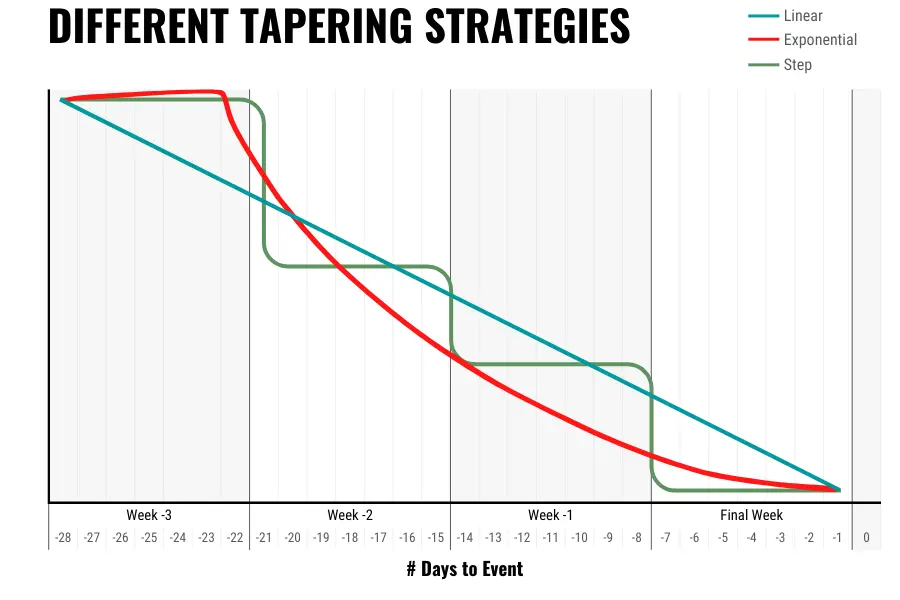
Customised Tapering: Do What’s Right for You
It’s likely that your personal circumstances; your on/off bike training experience, injury history, event importance and other factors, mean that the best tapering strategy for your circumstances is some form of hybrid of the options I’ve listed above, all modified to your individual needs.
Feel free to experiment, drawing from multiple methods; adjusting training volume and intensity based on what you need at that time.
- Example: An experienced cyclist with a history of successful linear tapers might decide to integrate elements of step tapering. Over a three-week period, training volume gradually decreases by 25%, but with intermittent bursts of high-intensity intervals in the second week to prevent monotony.
Optimising Strength Training During Taper
Whatever your riding standard, experience or goals on the bike, they are independent of your off-bike, gym-based experience. Therefore, how you taper your strength work should differ from how you taper your cycling.
For example, very experienced riders may begin their cycling taper 3-4 weeks before an event, but maintain gym work for much longer. On the other hand, I’ve worked with track sprinters (who are essentially weight lifters, who occasionally ride bikes), who have tapered their strength work and maintained on-bike efforts for longer!
Below are some of my recommendations when it comes to tapering strength. It’s important to understand that this advice is only for people who understand point #1 below and have developed enough gym-based experience to warrant a tapering strategy. If you are relatively new to strength work (under 12 months of experience), I wouldn’t bother with any form of official tapering, but I’d maintain a consistent approach for as close as you can to your event; just make sure to give yourself enough time between your final strength session and your ride so that you aren’t tired or sore.
A Year-Round Investment
Before we talk about tapering your gym training, it’s worth pointing out that strength work should be continually done throughout the year. It’s a cliche, but it’s true that “long-term consistency trumps short-term intensity” and this is especially true for strength training.
Even though the benefits of strength are evident, it’s still not very common practice for riders to get off their bikes and get into the gym regularly, so for most cyclists, strength training may be the edge you need; it can elicit many advantages without the drawbacks of spending many hours in the saddle.
Familiarity as a Shield
One drawback of strength training is its diversity and in the midst of your taper, the temptation to introduce new methods or exercises might be too much. After all, that guy on Instagram says this weird-looking exercise is the missing link that every cyclist needs to smash the competition!!
The fact is that good quality strength coaching consists of slowly getting better at a limited number of relevant exercises that eventually protect your body and transfer through to your on-bike ability. Resist the temptation to chop and change your programming, particularly during a tapering phase.
Tapering isn’t the time for novelty; familiarity is the key to reducing fatigue (and muscle soreness), limiting injury risk and maximising your performance outcomes.
Consistency in Set and Rep Structure
Similarly, the set and rep structure of your sessions should be relatively consistent, with planned out, gradual changes. As with changing the exercise, large changes in sets and reps will likely cause DOMS and pose an increased injury risk (for example, 10 sets of 3 is vastly different than 3 sets of 10, even though the “volume” is the same).
Consistency breeds comfort and confidence, ensuring that your body responds predictably to the training stimulus. The goal isn’t to shock your system but to ensure a seamless transition that supports your peak performance.
The Gradual Dimming of Volume
As the tapering period progresses, your strength training undergoes a deliberate transformation by gradually reducing the training volume. As mentioned earlier, how soon you do this depends on several factors and should be largely independent of what you do on the bike.
The first thing I like to do is remove secondary/finisher movements from the program (exercises like Bulgarian Split-Squats are beneficial, but can be particularly fatiguing), next, I’ll reduce the number of sets (i.e. completing 3 rather than 4 sets of 5), then finally I’ll reduce the number of reps per set.
These reductions are a calculated manoeuvre that preserves your hard-earned strength while allowing you to re-energise and recover in time for the main event.
Intense, Not Extreme
Finally, just as with your on-bike tapering, it’s important to maintain your strength tapering intensity throughout the taper, even as you start to reduce the volume.
This doesn’t mean you have to lift the heaviest weight you possibly can, but rather, a load heavy enough to stimulate the higher-threshold motor-units. This means weights around 80-85% of your one-rep max (1RM). This range strikes a balance – potent enough to stimulate, yet not so extreme that it crushes your central nervous system.
In addition, here are some other options I use to maintain intensity and minimise volume:
Cluster Training
In a normal training set, it’s the final few reps that cause the most damage. Think of cluster training like mini-sets within the main set, so rather than completing 3 sets of 6 reps (where the final 2-3 reps of each set could increase fatigue), you can complete 3 sets of 3 clusters of 2 reps (with a 10-15 second break between each cluster and 3-4 minutes recovery as normal between sets).
- Normal set = 3x 6
- Cluster set = 3x 2+2+2
This stimulates you in the correct way and avoids the fatigue associated with a normal set and like all other aspects of training, you can manipulate the reps within each cluster to fit your needs, for example:
- 3x 3+2+1
- 3x 2+2+2
- 3x 2+2+1+1
Plus many more! As with all other forms of training, don’t vary things for the sake of it, but create a thought-out plan in advance.
Dynamic Training
If our goal is to stimulate the high-threshold motor-units we must work against a high enough force. Force is calculated as Force (F) = Mass (M) * Acceleration (A) and we traditionally increase the mass (weight to be lifted) to increase force. Dynamic training focuses on the other side of the equation by concentrating on the speed at which you lift.
This is done by lifting the weight explosively during the upward phase of the exercise. For example, during a squat, lower down in control, then stand back up dynamically.
To keep the exercise as safe as possible, I lower the load to 60-70% 1RM, but even when doing this, what usually happens with this type of work is that you will slow down suddenly after 2-3 reps. Therefore, I typically prescribe 6-8 sets of 2-3 reps, making sure that you’re able to maintain speed throughout.
Concentric-Only Training
Most strength training exercises use a combination of different muscular contractions to complete. Typically, the descent or lowering phase involves an eccentric contraction, where the muscle works as it lengthens, an amortisation phase as you overcome the downward trajectory of the weight and a raising phase, which utilises a concentric contraction as the muscles shorten.
It’s generally understood that the lowering phase causes the most muscle damage and fatigue, so by eliminating this element from the exercise, you’re still able to stimulate the motor-units in the right way, without as much to recover from.
This is simple in theory, but much more difficult in practice – how do you get a weight from the top position to the bottom position safely, without an eccentric component? This conundrum is why I rarely use this technique.
- Concentric-only options – There are some exercises that lend themselves to concentric-only training. Deadlifts, for example, can be lifted from the floor and dropped back down (assuming you have a strong floor!!). Lowering a squat to the pins of a squat rack limits the eccentric loading and other exercises like sled pushing are concentric by default.
- Use spotters – If you train with other people, you can ask them to help you lower the weight, thereby reducing the eccentric load of each rep. However, this tends to be very time-consuming and you’re asking your training partners to perform eccentric-only training as all they’re doing is lowering weights for you!
Whichever way you look at it, concentric-only training is a faff and more trouble than it’s worth, although if you have the facilities and time to be able to perform it properly, it could be a good option for you.
Conclusion: The Art and Science of Tapering
To realise the benefits of all your training, having sensible, well-thought-out tapering strategies in place is essential.
These strategies should be personal to you and need to take into consideration variables like the importance of the event, your training experience, your current training state and other factors. Remember that your on and off-bike training is different and you may need different (but complementary) tapering strategies to achieve your peak performance.
With so many variables to consider, you’re unlikely to do things perfectly, so after your event/race, take some time to reflect on what went well and what you could do better next time.
Good luck.
